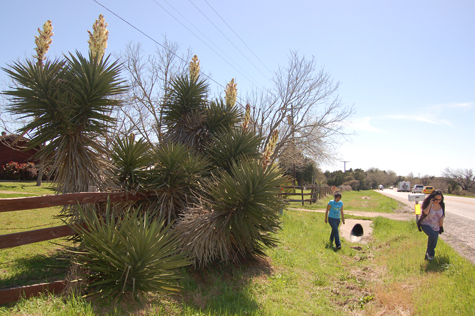Human Flower Project
Flor de Pita, for Lent
During the penitential season of Lent, the yucca of South Texas bloom; their blossoms are a traditional food of early spring.
 Spanish bayonet (Yucca aloifoli)
Spanish bayonet (Yucca aloifoli)
Fayette County, TX
March 13, 2010
Photo: Human Flower Project
Five and more years ago, when we were digging with special dirt-sailing tenacity for specifically Texan flower customs, we heard tell that in some parts of the state yucca flowers were eaten. But where, by whom, when, why, how? Finally last weekend, the mystery popped.
Cristina Balli, program director of Texas Folklife, and her associate Michelle Mejía, had toodled us down to Schulenburg for youth accordion auditions at the Sengelmann Hall. As we talked (waiting for squeezers to show up), Cristina recalled, “My mom used to cook flor de pita” – yucca—“and right around this time, during Lent.”
Cristina said that her mother, Antonia H. Balli, learned how to make yucca blooms into a meal from her own mother, Quirina Cruz de Hinojosa. Quirina grew up in Jalisco but after moving to Northern Mexico encountered Yucca aloifolia, which grows abundantly on both sides of the border near Matamoros/Brownsville.
Just as the dramatic plant blooms, in early spring, practicing Catholics are looking for meatless foods in observance of Lent. The luscious white and purple flowers, blooming throughout the brushy “monte” of the region, make a fine seasonal dish. One web source we’ve found claims that yucca flowers “have a clean, mild taste somewhat reminiscent of snow peas.” Cristina’s word is “bitter.” She calls flor de pita “an acquired taste.” (The same might be said for penance.)
As we drove prattling back up Highway 77 toward La Grange, Cristina jammed on the breaks just north of the St. Mary’s turnoff. Here was a stupendous stand of yucca in full bloom.
(We’re fairly sure this is Yucca aloifoli, known in Anglo Texas a Spanish bayonet; Spanish dagger, Yucca Gloriosa is lots more common around Austin.)
Spanish bayonet in Teri Popham’s yard, March 13, 2010
Fayette County, Texas
Photo: Human Flower Project
All three of us got out and met Teri Popham, who was standing in the yard with her curly little dog. Teri said that, yes, people have stopped by many times asking if they can cut the flower heads off her flor de pita. “I tell them take as many as you like,” she said. Teri’s mother planted the yucca out by the fence originally and gave away many cuttings, as well as flowers, through the years. (We wonder if she brought that plant to Fayette County from the border.)
Cristina Balli says that you can buy flor de pita stalks at the markets in Matamoros during March. We don’t recall seeing them at the H.E.B. in Austin, but maybe we haven’t been looking keenly enough. Or maybe we should head to the pulga.

Michelle Mejía and Cristina Balli explore a flor de pita cluster along Highway 77, north of Schulenburg, Texas
Photo: Human Flower Project
Many thanks to Cristina for turning a rumor Into a discovery, and to her mother, Antonia, for sharing this with us. All good things come to those who wait – well, some good things. No young accordionists turned up Saturday, but this recipe is music to our ears!
Flor de Pita (Yucca flowers)
From Antonia H. Balli, Brownsville, Texas
Fry onion and garlic with serrano peppers and one chopped tomato.
Rinse yucca flower petals. If in the bud, cut the ends off. If flowers have opened, use the petals and discard the center of the flower as is it bitter. (Antonia notes that the purple blooms are less bitter than the white ones).
Add petals and salt to the other vegetables, and cook quickly.
Serve in a warm corn tortilla.

